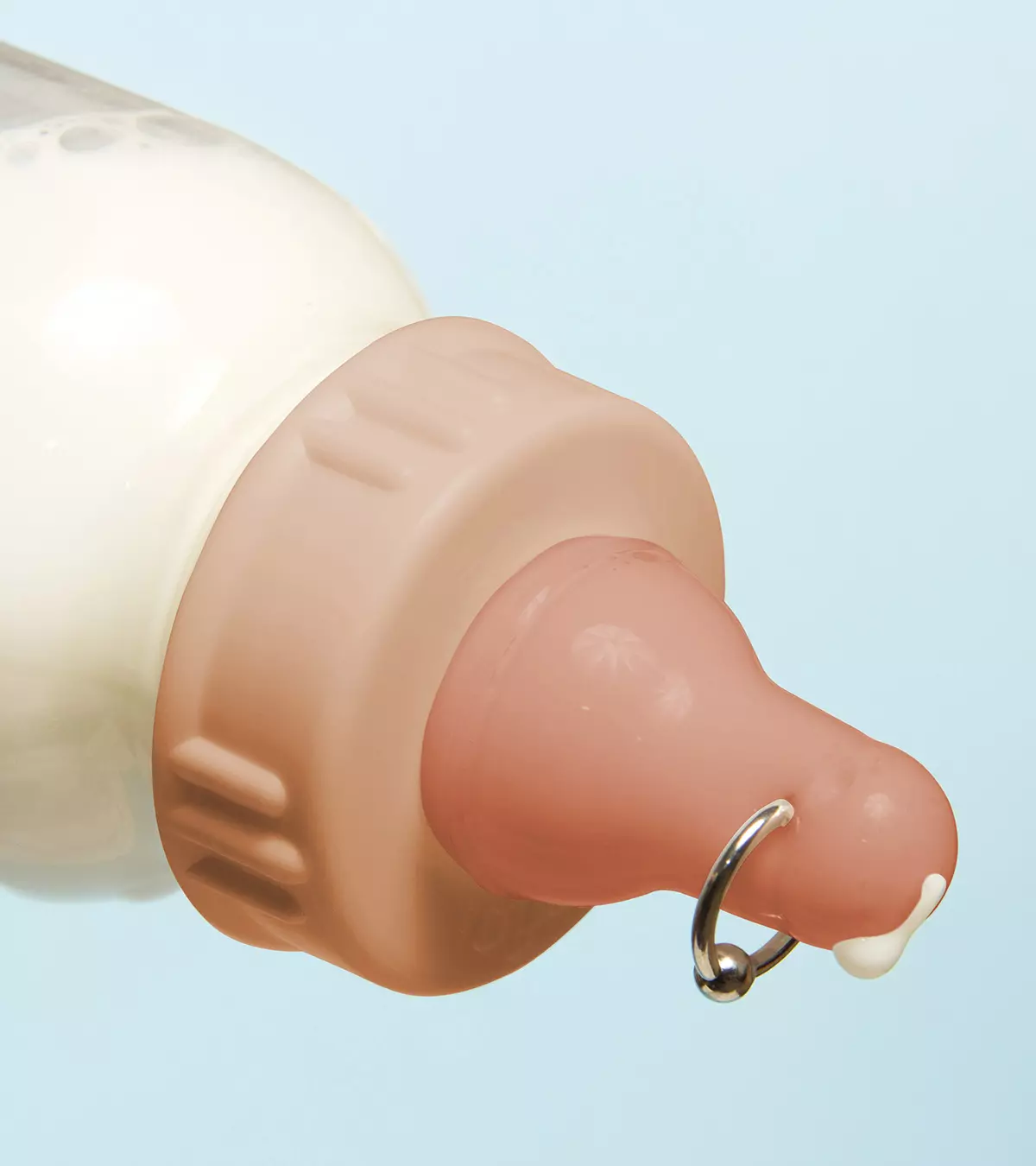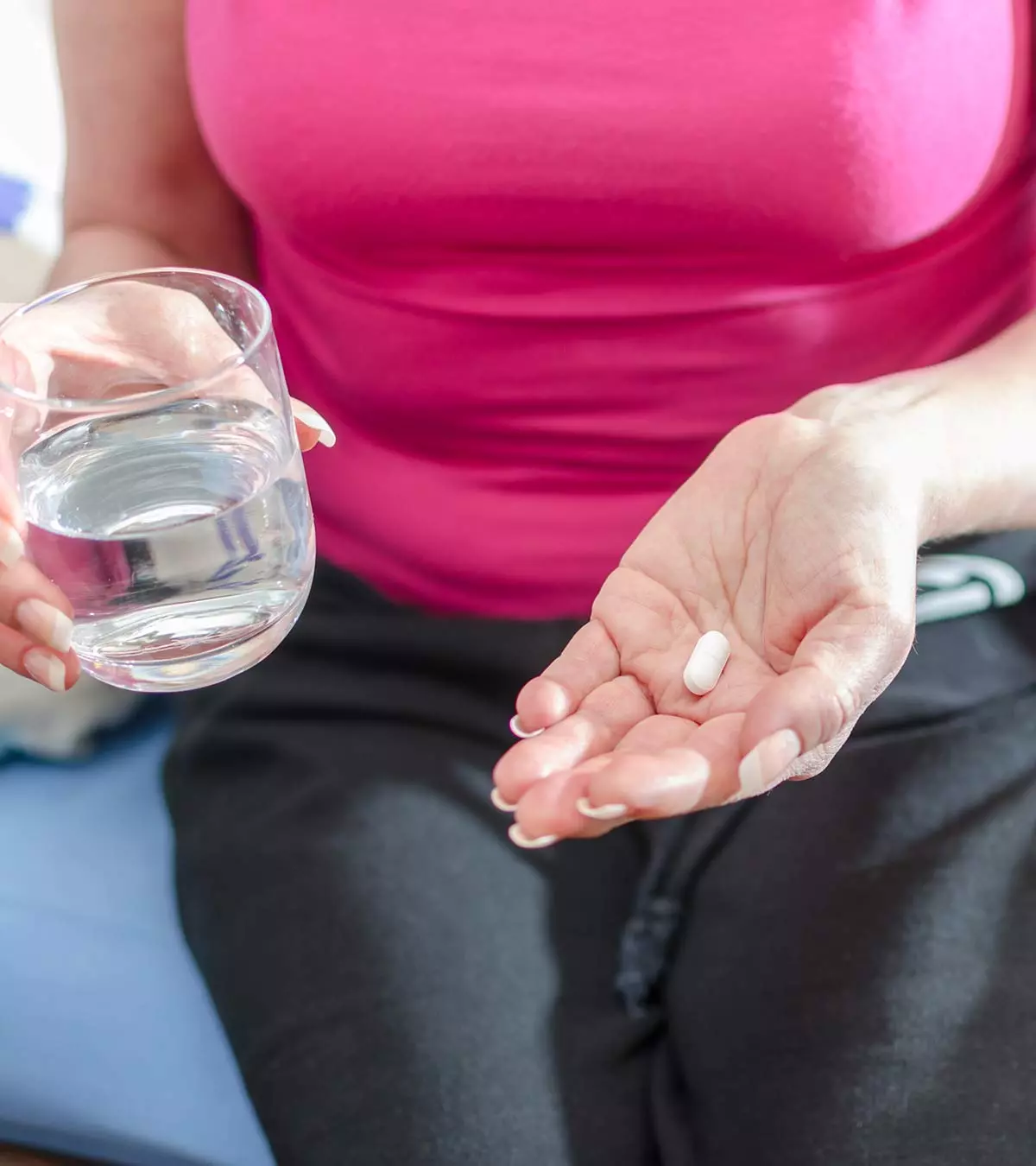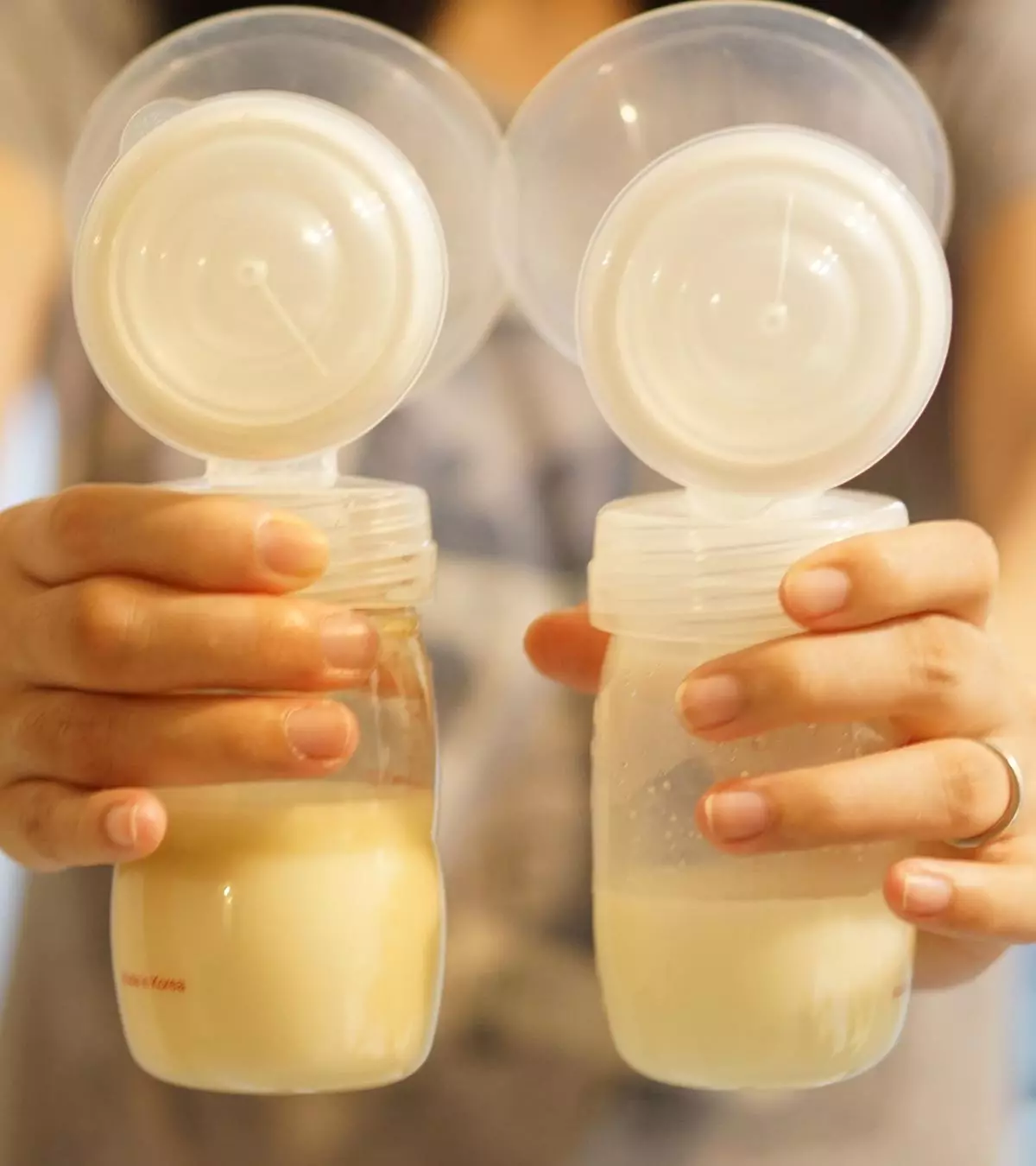
Image: ShutterStock
Breast milk is the best food for infants and provides them with complete nutrition. Expressing breast milk by hand and storing it for the future is a good option for mothers who cannot breastfeed their babies when required, but many new mothers may be confused about how to express breast milk by hand. Although breast pumps are available to allow mothers to express milk for their babies, expressing it by hand has its advantages. It prevents the hassles of cleaning and preparation, reduces breast engorgement, and prevents nipple soreness. However, before trying this method, you should remember some useful tips. Read the post to find complete information on why expressing breast milk by hand is a good choice and what precautions you should take while doing this.

Key Pointers
- Hand expressing breast milk has advantages such as not requiring cleaning and preparation of bottles, and reducing breast engorgement and nipple soreness.
- Proper hand washing and preparation are important before expressing milk to ensure hygiene.
- The process of hand expressing involves pressing, compressing, and releasing cycles to obtain proper milk flow.
- Gentle massage of the breasts is recommended while hand expressing.
- One should avoid stretching the areola, pinching the nipples, and squeezing the breasts while expressing milk to prevent injury.
How To Express Breast Milk By Hand?
Expressing breast milk by hand is an alternative to using the pump. The objective is to manually express milk and store it for later use. The process may seem tedious at first but is easier once you get it right. Here is how to express breast milk by hand (1) (2):
Step 1 – Preparation:

- Wash your hands with an antiseptic soap and dry them thoroughly. Your fingernails should preferably be short to prevent scratches while you express milk.
- Soak a washcloth in warm water and place it on your breast for a few minutes. It softens the breast tissue and also lets down the milk easily. You can also take a warm shower, which helps with relaxation and stimulates the let-down reflex.
- Sit on a comfortable chair and maintain good posture by sitting straight. Use your right hand to massage below the breast and under the nipple while using your left hand to massage above the nipple. This technique can help stimulate milk flow during breastfeeding while ensuring the massage doesn’t compromise your comfort.
- Slowly move the left hand to the left and the right hand to the right to massage the breast. Repeat the steps for massaging the left breast, with your left hand under the left breast and right hand on top.
- The circular motion stimulates the milk flow from the ducts towards the areola and nipples, while sitting straight makes it easier due to gravity. The stimulation massage should be gentle and not uncomfortable.
Step 2 – Expressing milk
- Keep a cup, bottle or a spoon beneath the nipple, ready to collect the milk.
- Place your thumb on top and the two fingers an inch behind the nipple and gently press back towards the chest. Do not squeeze or yank at the nipple.
- Milk may start flowing due to the initial pressure, which is only a stimulus to prepare the breast to secrete milk.
- Place the thumb and two fingers on either side of the nipple such that the fingers and thumb make a “C” or a “U” shape to flank the areola region. Now compress the breasts the same way you did previously.
- Soon you will notice a few milk drops trickling from the nipple. Collect them using a cup, bottle or a spoon.
- Once the milk starts flowing, continue applying gentle pressure on the breasts. First you press, then compress, and release the pressure. This is the milking motion cycle, and each cycle may probably give you a few drops to a teaspoon of milk.
- Collect as much milk you desire by repeating the cycle.
Step 3 – Finishing steps
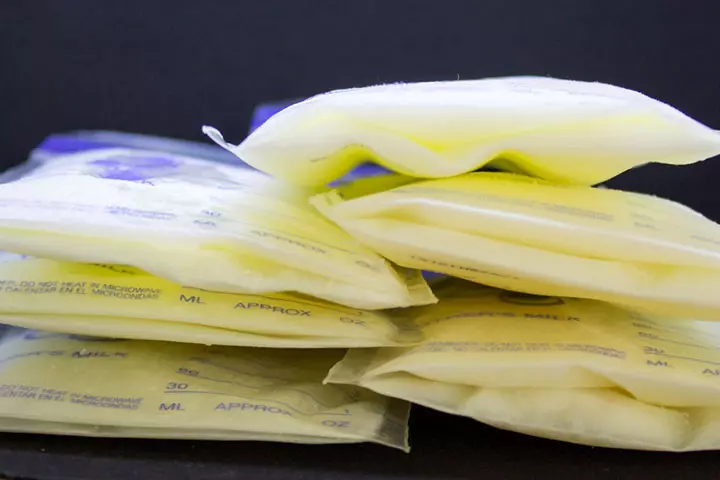
- If you have just started breastfeeding, then your milk let-down reflex will initially take about half-an-hour to stabilize.
- Don’t worry if you do not get the desired quantity of milk. Start again with a massage and then try the cycle of pressing, compressing, and releasing multiple times to get the milk flowing.
- Once you get the desired amount of milk, feed the baby immediately or refrigerate or freeze it in appropriate storage containers.
- Before feeding stored milk to your baby, follow the proper steps for thawing and warming to ensure it stays safe and beneficial.
 Experts say
Experts sayWhile the above technique works best, some women may adopt a different method or modify a few steps as they need.
Teresa Gumap-as Dumadog, a mother of three children, shares her experience with hand expression of breast milk, “I felt my left breast becoming fuller as my baby slept. I felt lumps around my breast. My left breast was becoming harder. So, I decided to massage my left breast. And as I slowly worked around massaging it gently, I saw some milk coming out from my nipple. I continued massaging my breast for a few more minutes, and more milk flowed. At one point, much milk actually squirted out of my nipple. That’s when I asked our maid to bring me a small cup that I could use because I had decided to express my milk by hand (i).”
So choose what’s best for you, but take precautions to stay safe.
Precautions While Expressing Milk By Hand?
Observe the following precautions when you express breast milk by hand (3):
- Massage gently: Massage the breasts very gently without stretching the skin. If your skin feels dry and stretched, apply a drop of oil on your palms before beginning the lactation massage.
- Never compress or pull the nipple and areola: Apply pressure only around the areola, but never on it. Do not squeeze or pinch the nipples since it can cause discomfort and injury.
- Do not stretch the areola: When releasing the pressure from the areola, do not stretch it. It can cause pain and increase the risk of cracked nipples.
- Do not squeeze the breasts: Compress the breast when expressing milk but do not squeeze it. Squeezing the breast will not increase the milk flow or supply, as milk supply is demand-based.
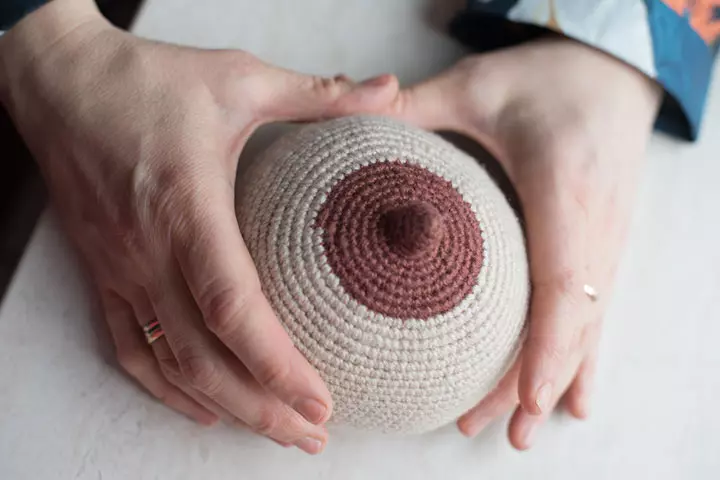
The above precautions make expressing milk by hand convenient and beneficial too.
What Are The Advantages Of Expressing Breast Milk By Hand?
Expressing milk by hand has several advantages, which makes the process worth learning (4) (5):
- Express with no breast pump: When you do not have access to a breast pump, you can express milk by hand. Also, you do not need a power source to express with your hands, which means you can do it anywhere.
- Preparation and cleaning are easier: You need to disinfect and clean breast pumps before and after use. However, there is no such hassle when you express milk by hand. Just wash your hands thoroughly before expressing the milk and use a sterile cup/bottle to collect the milk. Sterilization of milk containers is essential to prevent bacterial contamination of milk.
- Helps soften the breast before breastfeeding: Expressing some milk by hand softens the breasts and enables smooth flow of milk when the child starts feeding. This is especially important in the first days when your breast milk has fully come in and your breasts are engorged. The baby can latch easier when you soften the breast with your hand.
- Reduces breast engorgement: Knowing how to express milk with your hands lets you relieve the pressure in case of engorged breasts, especially when you have a milk duct infection such as mastitis. A manual breast pump may be rough on sore breasts, and expressing with hands can be a gentler alternative.

- May help prevent nipple soreness: Breast pumps are automatic, so you cannot always control how quickly or slowly they express milk. A breast pumping session can make your nipples severely sore. Hand expression of breast milk allows you to control the compression and also lets you take breaks as you like, reducing the chances of sore nipples.
- Cost-effective: Expressing milk by hand is more economical than buying or renting a breast pump.
- Familiarizes you with your breasts: Knowing how to hand express your breastmilk is also a good way to get familiar with your breasts and know when you may have a clogged duct or maybe something unfamiliar in your breasts that may need to be checked by a doctor.
 Quick fact
Quick factTeresa further highlights the advantages of this method. She says, “Actually, one of the reasons that I chose to do it by hand is because it would take a while before our maid could bring out my breast pump from the box and the cabinet, wash it, sterilize it, and then assemble it. I hardly use my breast pump because I’m home most of the time. Also, my hands get tired easily while using it, so I’d rather nurse directly. I felt that it was too much hassle. I’m glad I tried doing it today.”
Read on for more tips on how to express breast milk with hands.
Tips For Expressing Breast Milk By Hand

Expressing breast milk by hand can be tedious. Here are a few tips that can help make it less straining.
- Take the help of a partner: If you have difficulty expressing milk by hand, take your partner’s help and support. Your partner can hold the bottle/cup to collect the milk while you can focus on the process of expressing.
- Hand compression works anytime: There is no restriction on when you can compress by hand. You can do so in the middle of the night while sitting on the porch, or the first thing when you wake up in the morning.
- Consult a lactation expert when confused: If you find the process overwhelming or experience pain in the breasts, then consult a lactation expert for guidance.
 Quick tip
Quick tip
Next, we answer a few commonly asked questions about expressing milk by hand.
Frequently Asked Questions
1. Can I express milk by hand immediately after the baby is born?
Yes. You can express colostrum, which is the first batch of breast milk after the baby’s birth, by hand. You will probably get a teaspoon of colostrum, which is sufficient for a newborn.
2. Does expressing milk by hand yield less milk compared to pumping?
No, a study suggests that the quantity of milk expressed by hands is higher than that expressed by breast pump (6). In particular, during the early postpartum period, women produce thick colostrum milk and may suffer from breast-related issues like mastitis, breast engorgement, and blocked ducts, which can only be relieved through hand expression (13). Initially, you may not express much milk, but you will start producing an ounce (30 ml) of milk from the fourth day after delivery (7).
3. When is the best time to express milk?
If you aim to establish your milk supply without breastfeeding the newborn, you may need to express eight to 12 times per day, including at least once during the night, to match a baby’s natural breastfeeding pattern. You may plan to express after breakfast, mid-morning, after lunch, mid-afternoon, early evening, twice during the evening, and once at night. However, if the target is to improve milk supply, do it after or in between feeds (11).
4. How do I store expressed breast milk?
Use breast milk storage bags or food-grade containers made of glass or BPA-free plastic to store expressed breast milk. Containers should have tight-fitting lids. Freshly pumped milk can be stored at room temperature (77°F or colder) for up to four hours. For extended storage, use the refrigerator or freezer. Milk can be stored for up to four days in the back, not the door, where temperature fluctuations can diminish nutritional and antimicrobial properties. Store breast milk in the freezer for the best quality for about six to 12 months. Avoid disposable bottle liners not made for breast milk storage and any containers labeled with recycle number seven, as they contain BPA (12).
Breastfeeding holds innumerable benefits for the baby and the mother. However, several medical and non-medical reasons could make nursing non-viable. In such instances, hand expressing breast milk is a safe, economical, and effective way to keep your baby nourished. The process may seem difficult at first, but hand expression works faster than pumping as it gets better with practice and the right guidance. To ensure milk expressions go smoothly, massaging the breast gently and applying pressure only around the areola are a few necessary precautions to observe.
Infographic: What Benefits Does Hand Expression Of Breast Milk Offer?
Expressed breast milk is given to the baby, especially if the mother is working, traveling, unable to breastfeed, or if the baby is unable to latch onto the nipples. While an electric breast pump is available, if you wish to use your hands to express breast milk, the infographic below explains various advantages associated with the hand expression of breast milk.

Illustration: Momjunction Design Team
Illustration: How To Express Breast Milk By Hand? Advantages & Precautions

Image: Stable Diffusion/MomJunction Design Team
Learn to manually express breast milk with the help of the Infant Feeding Team. This instructional video will show you how to express milk quickly and easily.
Personal Experience: Source
MomJunction articles include first-hand experiences to provide you with better insights through real-life narratives. Here are the sources of personal accounts referenced in this article.
i. Expressing breastmilk by hand.https://mommytg.blogspot.com/2013/02/expressing-breastmilk-by-hand.html
References
- Hand Expressing Milk.
https://www.healthychildren.org/English/ages-stages/baby/breastfeeding/Pages/Hand-Expressing-Milk.aspx - Breast Care and Expressing Milk.
https://www.nationwidechildrens.org/family-resources-education/health-wellness-and-safety-resources/helping-hands/breast-care-and-expressing-milk - Hand Expression Technique.
https://www.med.umich.edu/1libr/Gyn/Lactation/HandExpressionTechnique.pdf - Hand Expression of Breastmilk.
https://med.stanford.edu/newborns/professional-education/breastfeeding/abcs-of-breastfeeding/hand-expression-of-breast-milk.html - Breastfeeding.
https://health.mo.gov/living/families/wic/pdf/HandExpression.pdf - Valerie J Flaherman et al.; (2011); Randomised trial comparing hand expression with breast pumping for mothers of term newborns feeding poorly.
https://pmc.ncbi.nlm.nih.gov/articles/PMC5332145/ - Expressing Breast Milk for Your Hospitalized Baby.
https://healthonline.washington.edu/sites/default/files/record_pdfs/Expressing-Breast-Milk-Your-Hospitalized-Baby.pdf - Hand Expression.
https://www.cdc.gov/infant-feeding-emergencies-toolkit/php/hand-expression.html?CDC_AAref_Val=https://www.cdc.gov/nutrition/emergencies-infant-feeding/hand-expression.html - Pumping Breast Milk.
https://www.cdc.gov/infant-toddler-nutrition/breastfeeding/pumping-breast-milk.html?CDC_AAref_Val=https://www.cdc.gov/nutrition/InfantandToddlerNutrition/breastfeeding/pumping-breast-milk.html - How to Express Breastmilk.
https://www.azdhs.gov/documents/prevention/nutrition-physical-activity/breastfeeding/expressing-breastmilk.pdf - Expressing your milk.
https://www.laleche.org.uk/expressing-your-milk/ - Breast Milk Storage and Preparation.
https://www.cdc.gov/breastfeeding/breast-milk-preparation-and-storage/handling-breastmilk.html - Expressing your breast milk.
https://www.guysandstthomas.nhs.uk/health-information/expressing-your-breast-milk
Community Experiences
Join the conversation and become a part of our nurturing community! Share your stories, experiences, and insights to connect with fellow parents.
Read full bio of Briana Violand
Read full bio of Swati Patwal
Read full bio of Rohit Garoo
Read full bio of Shinta Liz Sunny










